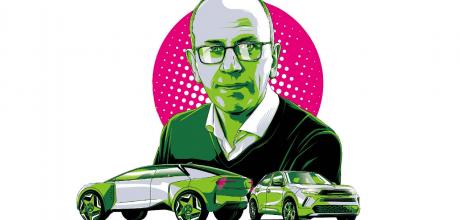Welcome to the future, Vauxhall
Paul Willcox was in charge for just 16 months. But Vauxhall will never be the same again. By Phil McNamara.
PAUL WILLCOX EX-VAUXHALL MD, NOW STELL ANTIS UK BOSS
THE CAR INQUISITION
Paul Willcox is in his final days running the most British vehicle maker of them all, Vauxhall. It’s been a brief, 16-month stint that’s packed a lot in: the Corsa dethroning Ford’s Fiesta as the UK’s top-selling car, the launch of the eye-catching Mokka, the pledge that Vauxhall will sell nothing but electric cars by 2028, and the transformation of Ellesmere Port into the UK’s first EV-only factory.
Next up is to oversee the UK performance of all nine Stellantis brands, from Alfa Romeo to Jeep to Peugeot. And unlike previous Stellantis UK boss Alison Jones, Willcox will also oversee Vauxhall. ‘It was separate because of its size, heritage [and manufacturing base]. But it’s been decided to roll it all into one, so for my sins I’ll have nine children. ‘Vauxhall is unique because it’s one brand serving one market, and the job was about driving that business. My new role [from 1 June] will be very different: it’s about maximising the whole business’s performance while maintaining brand separation.’
But we want to talk Vauxhall today, in his glass-walled office beside the M1 motorway in Bedfordshire. And the boss is on a roll, taking aim at Ford’s tardy E-Transit and government policy inconsistencies, which sets targets for cars to go electric without any matching charging infrastructure targets. He’d also like to see more financial incentives to go zero-emission, funded by higher taxes on gas guzzlers.
So is Willcox on a mission to electrify Britain?
‘I’m not sure it’s quite that. But we’ve made a very bold claim that we’re going to have everything electric by 2028. And we have a leadership position in electric light commercial vehicles, and we’re repurposing Ellesmere Port as an electric plant, a sign of our commitment.’
The last Astra rolled off the line in April (after 41 years); from March 2023, the Cheshire plant will be turning out the electric Combo van and its Life people-carrier variant, plus Peugeot and Citroën versions. Before then, a reinvention must take place: the huge site shrinking to improve logistics and reduce energy consumption, installation of battery pack assembly and new furnaces that can run on hydrogen, plus solar and wind energy – once Vauxhall secures planning permission.
Willcox is also fighting for the future of the Luton plant, which assembles combustion-engined Vivaro vans and their French counterparts. ‘I’m very keen to secure the investment in Luton, so we get two plants producing electric vans.’
The UK government threatening to rewrite the Northern Ireland trade protocol doesn’t help. ‘Every six months, we don’t need another flareup of anxiety about trade between Europe and the UK. We have big plans for the future but can only make them with stable conditions.’ Although Vauxhall’s light-commercial market share is growing, Ford sold almost four times Vauxhall’s 12,700 vans in the year to May.
It’s a different picture with electric vans (currently about three per cent of the market), which Vauxhall dominates, though the new E-Transit has superior range, driveability and tech. ‘Ford is spending a fortune on TV telling everyone they’ve got electric vans, but try your local Transit centre now [mid-May] and it’s a challenge to buy one! And by the time they get there, we might be on a different technology: we’re trialling hydrogen vans, which I’m trying to make a case to bring to the UK.’
Willcox says the Corsa is the top-selling electric supermini, and the Mokka the best-selling small SUV for retail customers (though total sales lag Ford’s Puma’s). And the range overhaul continues with next year’s electric Astra and a Crossland replacement in time, while the Insignia has quit the UK. ‘It stays in other markets, but it wasn’t sustainable here. But we will have cars to fill the higher end of the line-up.’ One halo model that Vauxhall has shown in a conceptual sketch is the 2025 Manta, a mid-size electric crossover with 440 miles of range and dramatic styling.
From staid Insignia to zeitgeisty Manta. ‘We need to bring in products that help consumers understand we’re an electric brand,’ says Willcox, ‘so we’ll move faster than most to become visibly electric.’
HE’D LIKE TO SEE MORE FINANCIAL INCENTIVES TO GO ELECTRIC, FUNDED BY HIGHER TAX ON GAS GUZZLERS
THE CAR CURVEBALLS
Six questions only we would ask…
Tell us about your first car ‘My first car was a Mini 1000, more rust than paint. My second car was a Panther Lima, 2.3 Firenza engine.’
Which achievement makes you most proud?
‘Taking Nissan to number one Asian brand in Europe.’
What’s the best thing you’ve ever done in a car?
‘At the Nürburgring in a mule GT-R (R35), an Infiniti coupe on steroids. The pilot was an ex-F1 test driver who spoke no English and was on it. It was a fantastic experience but I felt as sick as a dog afterwards.’
Tell us about a time you screwed up…
‘As head of Europe, I brought Datsun into Russia. A difficult challenge.’
Supercar or classic car?
‘I used to love Group B rally. Hannu Mikkola told me about when he got the call from Audi [about the Quattro]. They said it was a 4x4, which he thought was just for tractors, but then he drove it and it was great!’
Company curveball… why the griffin badge?
‘The boss at the time sent someone to Luton library, who discovered the griffin had a deep local history.’
Movano-e has helped Vauxhall’s lead in light commercial EVs


